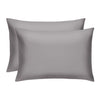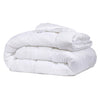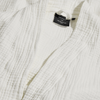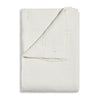The Daily Miracle
Satin vs Silk: How To Tell the Difference
Published
September 19, 2024
Author
Miracle Brand

Ever found yourself staring at a sea of bedding options, wondering what on earth the difference is between satin and silk? Are you unsure how to decide which materials are best for you?
You’re not alone! Both are luxurious, both feel amazing, but they are definitely not the same. Let's break down the differences so you can make the best choice for your sleep sanctuary.
What Is Satin?
Satin is a fabric weave that creates a smooth, glossy surface, often mistaken for silk because of its luxurious feel. Unlike silk, satin can be made from various materials, including polyester, nylon, and even silk. This versatility allows satin to be both affordable and high-end, depending on the materials used.
Its history dates back to medieval China, where it was first produced from silk. The term "satin" actually comes from the name of the Chinese port town, Quanzhou, known as Zayton in medieval Arabic. This fabric quickly became popular in Europe, especially in the courts of royalty, due to its shimmering appearance and luxurious touch.
Creating satin involves a specific weaving technique where four or more fill yarns go over one warp yarn. This method gives satin its signature sheen on one side and a dull finish on the other. The materials used for satin can vary widely, including silk, polyester, nylon, and acetate, which impacts its price and durability.
Satin is known for its glossy appearance and smooth texture. It drapes beautifully, making it a popular choice for clothing, especially evening wear and lingerie, as well as luxurious bed linens. The sheen and smoothness of satin come from how light reflects off its surface, creating a glamorous look.
What Is Silk?
Silk is a natural protein fiber produced by silkworms, specifically the larvae of the moth species Bombyx mori. The history of silk dates back thousands of years to ancient China, where it was discovered and valued as a symbol of luxury and status.
According to legend, silk was first discovered by the Chinese Empress Leizu around 2700 BCE when a cocoon fell into her tea, unraveling to reveal a delicate, strong thread. For centuries, the process of making silk was a closely guarded secret, making it a highly prized commodity that was traded along the Silk Road. Unlike satin, which refers to a weave, silk refers to the fiber itself.
Silk production, known as sericulture, involves harvesting silkworm cocoons. These cocoons are carefully unwound to produce long fibers, which are then spun into silk threads.
There are different types of silk, with mulberry silk being the most common and valued for its uniformity and sheen. Other types include tussah, eri, and muga silk, each with unique textures and colors.
Silk is celebrated for its natural sheen, soft texture, and breathability. It’s hypoallergenic, making it an excellent choice for those with sensitive skin. Silk’s natural temperature-regulating properties keep you cool in summer and warm in winter, providing comfort across all seasons.
Additionally, silk is known for its strength despite its delicate appearance, being one of the strongest natural fibers.
How Do You Tell Silk and Satin Apart?
Distinguishing between silk and satin can be tricky, especially since both fabrics have a luxurious look and feel. However, a few key differences can help you tell them apart.
First, consider the texture. Silk has a natural, soft, and almost creamy feel, whereas satin, particularly when made from synthetic fibers, tends to be smoother and sometimes a bit slippery.
Next, take a close look at the fabric. Silk has a more natural sheen that reflects light softly, giving it a subtle, elegant glow. Satin, on the other hand, has a high-gloss finish that is more reflective and can appear shinier.
Another way to differentiate them is by checking the fabric's warmth. Silk is known for its breathability and temperature-regulating properties, feeling cool to the touch yet warming up quickly. Satin, especially if made from polyester, can feel cooler but doesn't adapt to body temperature as effectively as silk.
Lastly, examine the price and care instructions. Silk is generally more expensive due to its natural origin and labor-intensive production process. It also requires more delicate care. Satin, being more affordable and easier to maintain, might have simpler care instructions, especially if it’s made from synthetic materials.
What Are the Best Sheets for You?
Now that you can tell the difference between these materials, it’s decision time — what’s the best bedding for your preferences and lifestyle? With numerous options available, it can be overwhelming to find sheets that tick all the boxes.
That’s where our Extra Luxe Miracle Sheet Set steps in to transform your sleep experience.
Infused with silver, these sheets help keep you at the perfect temperature and prevent up to 99.7% of bacteria growth, ensuring a clean and refreshing sleep environment every night.
The silver infusion acts through a natural ionization process that disrupts the reproduction of bacteria, maintaining minimal bacterial presence even after extended use. This not only helps in reducing unpleasant odors but also significantly decreases the frequency of laundry.
Additionally, the temperature-regulating properties of these sheets help mitigate night sweats, providing a cool, comfortable sleep. By upgrading to these innovative sheets, you invest in a cleaner, healthier sleep environment, contributing to better overall well-being.
What's the Best Detergent for Keeping Bedding Fresh?
If you’re wondering how to get body oils out of sheets or otherwise how to care for your new bedding, it all starts with the detergent. Choosing a detergent that is effective yet gentle on your skin and the environment can make a significant difference in maintaining the quality of your bedding.
Our Miracle Made® Laundry Detergent Sheets are crafted to deliver a powerful clean without compromising on safety or sustainability. Their compact and convenient design makes laundry effortless while ensuring your sheets stay fresh and free from harmful chemicals.
These sheets dissolve in seconds in both hot and cold water, making them compatible with all types of washing machines, including HE models. They are also safe for use with septic and graywater systems. The formulation includes just four natural ingredients, which means you can achieve a thorough clean without exposing your laundry to harsh chemicals.
Unlike traditional detergents that can be bulky and messy, these sheets are ultra-concentrated, fitting neatly into a small box that takes up minimal space. This makes them ideal for anyone looking to declutter their laundry area while still achieving deep-cleaning results.
The all-natural, vegan, and cruelty-free ingredients include coconut oil, alcohol, natural vegetable oil, and coconut oil extract, ensuring that your laundry is both clean and safe for your skin and the environment.
The Bottom Line
So, satin or silk? It all boils down to personal preference. Satin offers a more affordable, durable option with a luxurious feel, while silk provides unparalleled softness, breathability, and hypoallergenic benefits. Whichever you choose, the key to a great night's sleep lies in high-quality, clean bedding.
For those looking to elevate their sleep experience, consider Miracle Made® Sheets. With their silver-infused, bacteria-fighting properties, they offer a cleaner, fresher sleeping environment. Pair them with Miracle Made® Laundry Detergent Sheets for a truly effortless and eco-friendly laundry routine.
Sleep better, live better — it’s as simple as that.
Sources:
Antibacterial Silver | National Library of Medicine
Best Materials for Bed Sheets | Sleep Foundation
The History of Silk | Silk Association of Great Britain
Satin Fabric: History, Properties, How It’s Made | American Textile History Museum


























